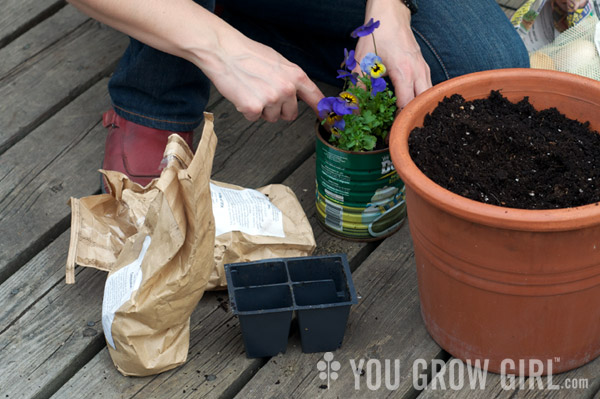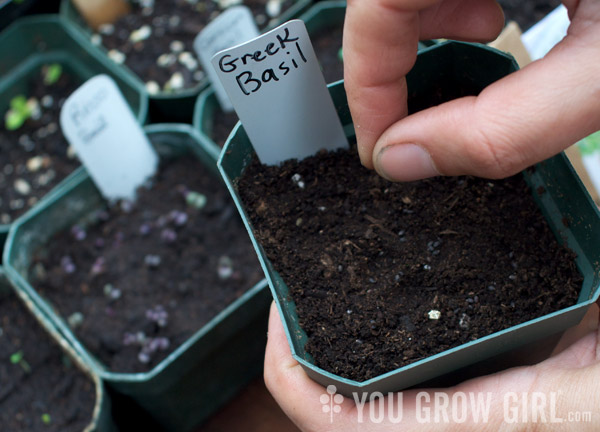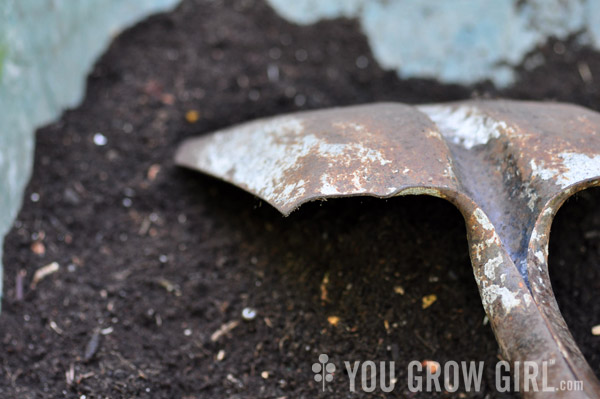
Questions about seed-starting and potting soil brands are some of the most popular that I receive. They’re tricky to answer because I’ve found that many of the best quality potting soils or soil-less mixes tend to be produced by smaller companies with short distance distribution. In terms of quality and ingredients, soil mixes vary widely — availability in your area will be very different than mine. Besides, I think there is something inherently problematic in wasting resources and money shipping potting soil long-distance. It makes more sense that this would be such a localized product.
My best answer is that it really pays to do your homework and spend your money wisely in this area. I am only comfortable recommending products that I have personally tested, or at the very least, have had the chance to touch and see.
What I can tell you is that I unequivocally do not use and do not recommend anything with the Miracle Gro name on the bag, regardless of whether or not it has OMRI (Organic Materials Review Institute) certification.
Here’s why:
Regardless of the quality of the product, The Scotts Miracle Gro Company is a Monsanto supporter and the exclusive distributor of RoundUp, a Monsanto product. I am committed to gardening organically, and as sustainably as possible and part of that goal is directed at keeping Monsanto and Big Chemical out of my garden in whatever form it takes. They may produce a so-called “organic” line, but as I see it, they want their feet in both worlds and wherever they can get our money. I garden on a budget, but I want the money that I do spend to support companies that are truly committed to the principals of organic gardening and sustainability. Any company that is in bed with Monsanto and continues to produce its own chemically-laden products is not truly invested in anything more than meeting their bottom line.
It used to be that I could talk about the practices and brands that I support while keeping silent about the brands that I don’t. But things have changed. These products are everywhere, and in many communities they are all that is available. Walk down the gardening aisle of any Home Depot, Target, or other department or big box/d.i.y store and they are all you see. New gardeners are often overwhelmed by their own fear of failure and pressured by marketing that leads them to believe that these products are necessary to grow a garden.

How to Find a Good Brand
– Ask around from sources that you trust: A good place to start may be a local community garden, garden shop, or farmers’ market that is committed to selling, using, and promoting ethically responsible organic brands.
– Look at the ingredients listed on the bag: A good potting mix will contain organic matter such as compost, seaweed, manure or mushroom compost, bat guano, bone meal, soybean meal, soft rock phosphate, greensand, fish meal, blood meal,and/or worm castings (to name a few) to provide nutrients. Some mixes contain slow-release, chemical fertilizer pellets that are not considered organic. Perlite, vermiculite, wood chips, rice hulls, turface, chicken (or other) grit, and/or sand is added to prevent compaction and increase drainage. Peat or coir (a renewable resource and peat substitute derived from coconut husks) are two common ingredients used to to absorb water.
– Lift the bag: I know this seems a bit shallow, but I find this is a good quick rule-of-thumb when you’re in a rush and you can’t see inside the bag or an ingredients list. I call this the 3 Bears Method. A bag of potting soil that feels really heavy for its size tends to be full of cheap fillers and compost. Depending on the source of the ingredients, it may be fine for the ground, but in a pot too many dense ingredients will compact and cut off air circulation in the soil. This inevitably leads to rot. Soil that feels too light for its size — not unlike picking up a bag of popcorn — may be heavy on peat, vermiculite, and perlite and lacking in the nutritional matter that plants need to stay healthy. Your best bet is with a bag of soil that feels “just right” for its size. These mixes tend to have a decent balance of nutritional matter and gritty ingredients to help prevent compaction.
When your choices are between a mix that is too heavy or too lightweight, opt for the light and make your own additional amendments based on nutritional need. I find this option is better because you control the source of organic matter i.e. compost, manure, etc. If you do not have compost at home and have to buy this product too, I would opt for vermicompost over any other type. It is lighter weight (avoiding compaction) and I find that small, local, vermicompost brands tends to be more trustworthy (again this is a very general rule-of-thumb, but I’m talking here about when you’re at the store and don’t have the ability to research).
Choosing seed-starting mix: Look for a brand that says it is for seed-starting specifically. Regular potting/container soil ingredients vary wildly and often contain large-sized bits and pieces that can hinder seedlings from pushing up to the soil surface. Seed-starting mixes also tend to contain more moisture-retaining ingredients, yet are light and airy to increase drainage. This is one area where the “3 Bears Method” does not apply. Many brands now include mycorrhizae fungi in their mixes. I think this is a good thing, but I’m a bit worried about how these soils are stored so prefer to add my own.
What about brand name pellets and compressed pots? Don’t do it. They’re more expensive than a bag of seed-starting mix and you can use just about anything from the recycling bin (as long as you add drainage holes) as a free pot. Pellets and paper pots dry out quickly and I find that they tend to swing between either being too dry or too wet, which is a recipe for plant stress and disease. I find them useless for fast-growing plants like tomatoes that need to be moved to a bigger pot in no time. Save the step and just start the seed in a pot.

Potting Soil Alternatives:
It may seem daunting, but preparing your own mixes is rewarding and cheaper in the long run. The tricky thing for small space gardeners is often in finding a place to store the overflow. Believe me, I get it. I have a basement and a shed now, but I gardened for years without storage space of any kind. In that case I suggest buying smaller bags of individual ingredients. Mix them up in a sealable bin and store it wherever you can. In my case that meant out in the open so I opted for the nicest looking container I could find. Keep it sealed. I once found a raccoon sleeping in mine!
All you need really are two basic mixes: a seed-starting mix and a basic potting soil that you can amend based on the needs of individual plants.
Basic Seed-Starting Mix
1 part sifted coir or peat
1 part perlite (best if you can find a fine grade)
1/2 part vermiculite (I used to use 1 part but have started using less).
You can add a bit of sifted and sterilized compost, or vermicompost to this (no more than 20%) or wait until the seedlings have produced their first set of true leaves and start to scratch a small amount at a time into the soil surface. I have started experimenting with mycorrhizae added to my mix, but can’t report on that yet.
Basic Potting Soil
2 parts coir or peat
2 parts sieved compost
1 part course sand (builder’s. Make sure it is free of herbicides), grit, and/or perlite
1 part vermiculite (optional, but I like it for water absorption)
You may need to add nutrition based on the type of plant you intend to grow in the pot. I do not add it to the basic mix so that it can be amended further (with more grit) to make potting soil for herbs, cacti, and succulent plants that do not require as much soil nutrition. This page from the National Sustainable Agriculture Information Service can help further in choosing the right organic nutrients for your mix.
Potting soil is just so tricky, I agree. I like buying the mix that the local garden store makes or brands themselves. I once was seduced by Miracle Grow brand organic potting soil because it was cheap and came in a size perfect for my small apartment closet, only to be run out of house and home by fungus gnats. Never again.
I’ve never used the brand, but I’ve have heard this complaint from many who have.
Great article!
This year is my first for what I’ll call ‘large scale; seed starting. In the past it’s been a couple of items, but this year I went a little wild. A big mistake I made, in my opinion, was buying very fertile soil, (Happy Frog is the brand) and I used it to pot up my seedlings after they came out of cell packs. Big mistake…everything just grew so darned fast. Great soil by the way, but definitely not a good idea considering I also started my seeds far too early. Lesson learned!
I agree with what can happen with fertile soil. This isn’t a problem when direct sowing outdoors because conditions can support the leap in growth. I personally prefer a more inert seed starting soil for this reason, and I add my own nutrition as the plants need it. However, I get why companies make such fertile soil — new gardeners require a more all-in-one package.
Thanks for the info! I chose Black Gold (one with orange flower on it) for my potting soil mix and it seems to work well and is OMRI. It was at Westlake Ace Hardware, if anyone wanted to know, and is affordable.
Just another comment on pots vs. Peat pots/paper pots. I hate the peat pots. Every time I’ve used them I end up with mold, such a mess, and a recipe for damping off. I used to use single serve yogurt cups with holes drilled in the bottom and that worked great. Now that I make my own yogurt I use a set of plastic cups that I bought 3 years ago, also with holes drilled in the bottom.
Another super useful method, take your empty milk jugs, half or full gallon, cut the bottom off about 1/2 of the way up. Fill the bottom with seed starting mix, plant you seeds (I like this method for peppers and tomato’s in particular) put the top on and you have instant baby greenhouse, take off the cap to vent!
I have a bunch of recycled containers that I wash and reuse every year — different pots in a range of widths and depths depending on the plant. I have to admit that I’m quite possessive of them. Probably because it took time to collect and prep the ones I like best!
Is there a sustainable/responsible alternative to coir? I’d love to make my own mixes and avoid peat (which is what I have to opt for at the moment) but coir just isn’t an option to risk in my house. I have coconut allergy and have no idea if I’d react to this product or not and I’d rather not test it. Frustrated…
I’ve never heard of a coconut allergy so I really appreciate that you’ve mentioned this. I didn’t get into it here, but I’m really on the fence about coir as a sustainable alternative. It has lots against it, too, but right now, when given a choice, I lean toward it over peat. That said, it would take some experimentation, but there are things you can do without using either. Local tree bark that has been finely shredded and composted is one option, but it can be difficult to find or would take doing the extra work yourself. I’ve heard of people using finely shredded newspaper (being careful about what was used as ink). I think this would be a viable option with seed starting since you wouldn’t need as much and its something I’ve been thinking about trying this year since I have used the same as bedding for worm bins. Some people forego alternatives and just use compost or leaf mould/humus with more grit to prevent compaction. But with seed-starting you get into issues of sterilization, which again is something you’d have to do yourself. I also worry about too much nutrition too early for seedlings. Not a problem when you’re direct sowing outdoors, but definitely can be inside underneath lights.
Here in Los Angeles I am a huge fan of EB Stone Organics Potting soil. Were life going my way I would have some dark rich compost to mix in but not for now….not giving up though :)
Here in Los Angeles I am a huge fan of EB Stone Organics Potting soil. Were life going my way I would have some dark rich compost to mix in but not for now….not giving up though :)
I have not had good luck with Miracle Gro brand soils and lately it seems to be all I see at the stores. I refuse to purchase it, trying to “speak my mind” with my wallet. I favor mixing my own potting soils and always add my own finished sifted compost to the recipe.
Having used peat pots a few times years ago, I recall them continuously “wicking” away moisture from the root ball if they stuck up above the soil level too much, having been placed too high originally or after settling of the soil exposed them too much. They seem like a wasted step when the gardener could have better success with directly transplanting instead of worrying about the peat pot later.
Gayla – Have you ever tried soil blocks? Considering the number of seeds that i tend to start, i’ve had decent luck using soil blocks to start a number of seeds in. (This is the first year i’ve used the mini soil blocks (3/4 inch cubes) that are then potted on to the larger 2” blocks.)
Also, being from Pennsylvania (where we grow a lot of mushrooms in the abandoned coal mines), mushroom manure is a wonderful local product i use in all of my potting soils (but not for seed starting – too coarse… that said, the coarseness is nice for aerating the soil mix for full size container plants). I’m also looking forward to a product called PittMoss to be available one day (right now, it’s only available to commerical growers in the Pittsburgh area where i live)…
I bought a soil blocker a few years ago to try out…. and I did… a number of times. I just don’t like them. I don’t dislike them as much as fibre pots or pellets… but for me they don’t compare to potting into a container that is the right size and shape for the individual plant.